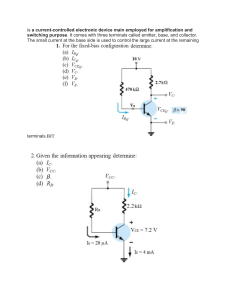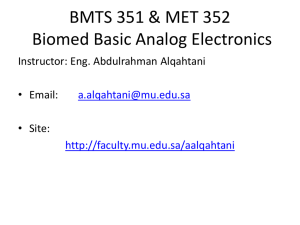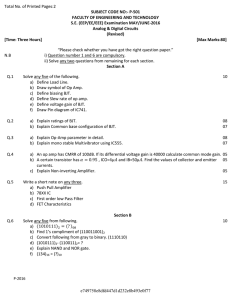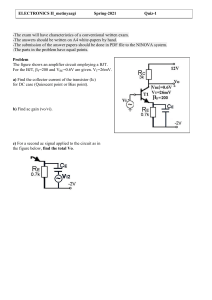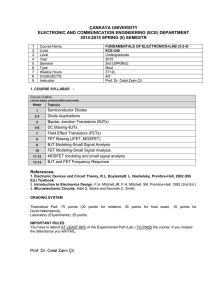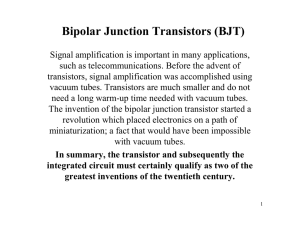Transistors: BJT & FET Basics, Characteristics & Applications
advertisement
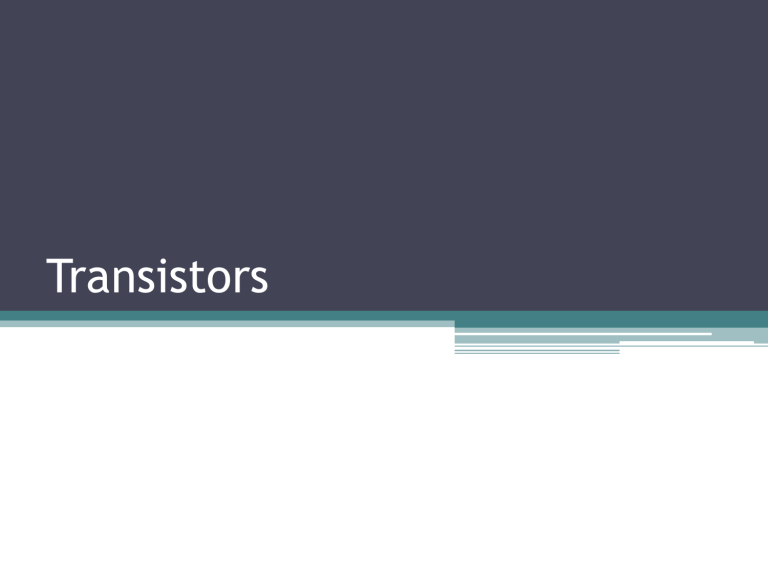
Transistors Transistors BJT (PNP) Electrical Diagram Different types and sizes FET and BJT Transistor Modern Electronics First Transistor • Purpose ▫ To amplify and switch electronic signals on or off (high or low) • Modern Electronics Microprocessor Motor Controllers Cell Phones Vacuum tubes • Purpose ▫ Used as signal amplifiers and switches ▫ Advantages High power and frequency operation Operation at higher voltages Less vulnerable to electromagnetic pulses ▫ Disadvantages Very large and fragile Energy inefficient Expensive Invention • Evolution of electronics ▫ In need of a device that was small, robust, reliable, energy efficient and cheap to manufacture • 1947 ▫ John Bardeen, Walter Brattain and William Schockly invented transistor • Transistor Effect ▫ “when electrical contacts were applied to a crystal of germanium, the output power was larger than the input.” General Applications P-N junction Forward Biasing Reverse Biasing • P-N junction ▫ Controls current flow via external voltage • Two P-N junctions (bipolar junction transistor, BJT) ▫ Controls current flow and amplifies the current flow Transistor Categories • • • • • • • • Semiconductor material Structure Polarity Maximum power rating Maximum operating frequency Application Physical packaging Amplification factor Types of Transistors • Bipolar Junction Transistor (BJT) • Field Effect Transistors (FET) • Power Transistors BJT Introduction • Bipolar Junction Transistors (BJT) consists of three “sandwiched” semiconductor layers • The three layers are connected to collector (C), emitter (E), and base (B) pins • Current supplied to the base controls the amount of current that flows through the collector and emitter BJT Schematic • NPN NPN ▫ BE forward bias ▫ BC reverse bias • PNP ▫ BE reverse bias ▫ BC forward bias PNP BJT Characteristic Curves Transfer Characteristic • Characteristic curves can be drawn to show other useful parameters of the transistor • The slope of ICE / IBE is called the Transfer Characteristic (β) BJT Characteristic Curves Input Characteristic • The Input Characteristic is the base emitter current IBE against base emitter voltage VBE • IBE/VBE shows the input Conductance of the transistor. • The increase in slope of when the VBE is above 1 volt shows that the input conductance is rising • There is a large increase in current for a very small increase in VBE. BJT Characteristic Curves Output Characteristic • collector current (IC) is nearly independent of the collector-emitter voltage (VCE), and instead depends on the base current (IB) IB4 IB3 IB2 IB1 BJT Operating Regions Operating Region Parameters Mode Cut Off VBE < Vcut-in VCE > Vsupply IB = IC = 0 Linear VBE = Vcut-in Vsat < VCE < Vsupply IC = β*IB Amplification Saturated VBE = Vcut-in, VCE < Vsat IB > IC,max, IC,max >0 Switch ON Switch OFF BJT Applications BJT Switch • Offer lower cost and substantial reliability over conventional mechanical relays. • Transistor operates purely in a saturated or cutoff state (on/off) • This can prove very useful for digital applications (small current controls a larger current) BJT Applications BJT Amplifier BJT Applications BJT Amplifier Field Effect Transistors (FET) Chase Thompson FET Basics • Electric Field • Voltage Controlled • FET includes three distinct pieces ▫ Drain ▫ Source ▫ Gate FET versus BJT? Same: • Applications: amplifier, switch, etc. • Relies on PNP or NPN junctions to allow current flow Difference: • Voltage vs Current Input • Unipolar vs Bipolar • Noise • Higher input impedance • Fragile and low gain bandwidth
